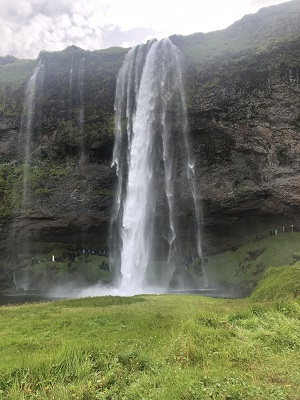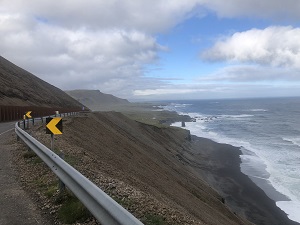
Synonymous with road trip vibes, the Ring Road, Iceland is a must-do drive for those looking for spectacular scenery. The Ring Road is in fact the nickname of Route 1, Iceland’s main motorway. This route loops the island in a full circle, skirting around Iceland's central, uninhabited highlands. Along the way around the Ring Road, you’ll find the most popular tourist attractions. This includes the Seljalandsfoss and Skógafoss waterfalls, Dyrhólaey cliffs, and Jökulsárlón glacier lagoon. If you're planning an Icelandic road trip, it’s likely you’ll end up on this route, whether you’re doing the full circle or a shorter trip. The Ring Road is 1,328 kilometres long (825 miles).
The Ring Road covers most of the country and it needs less than 7 days in Iceland to drive and visit the best spots. This is for a comfortable, but express route around the island. From there, you can extend it to discover some regions in more details, to take detours, and explore remote corners. Plus, the speed limit for most of the way is 90 kilometres per hour (55 miles per hour), and speeding fines aren't cheap. So it’s best you slow down and enjoy all the scenery along the way. Most visitors choose to drive Iceland’s Ring Road in summer. At this time of year, the midnight sun gives you plenty of extra daylight for driving and sightseeing. But winter road trips are also possible, and growing in popularity and you may even spot the northern lights in the dark skies.
It’s better to rent a 4x4 vehicle for a road trip between October and April as it will make driving in such conditions easier or move in off road track that start from Ring towards the center of Iceland. Take care that in Iceland, motorists drive on the right side of the road and left side of the car like in Us and Europe (excluding Uk).
Preparing for Iceland is not a matter of filling suitcases, on the contrary, empty the cache, free up space and expand the memory space, you will need it.
Iceland will flood you with images and memories to capture as its rushing waterfalls.

If I were a very old woman with slowed reflexes, blurred vision and an expiring driving license that no conscientious doctor would renew, I would say goodbye to road driving with an automatic transmission, on the N1, the Ring, the Icelandic national road which it goes around the island of glaciers and volcanoes, to be covered strictly anti-clockwise. Direction matter: an act of generosity towards your passenger who will enjoy the view of the sea almost constantly.

What will immediately become evident, however, is that the water that reaches the sea from the right arrives disruptively from the left.
You won't count the waterfalls after the tenth, but none of them resemble the previous one and you will stop at all of them, with your nose in the air and wondering where so much strength comes from.
Detours guaranteed, good excuses for a break and a snack.
The south has only three colors: white, black, blue.
Sometimes the white of the glacier is stained by (black) lava dust. Very often it reflects water and appears blue. The sheep are also white, the only true and undisputed masters of the island. Don't ask yourself where they go and who they belong to: they are everywhere.
During your trekking you will find gates. Make sure you close them diligently behind you. It will make your conscience clear but they will find a way to get in anyway, the impertinent woollies.
And be careful of the sheep when you travel along dirt roads: if it is true that they ignore motorists, you will most certainly find the quadrupeds in the middle of the road licking the salt spread by their owners to prevent the formation of ice.
Going to the Ring is relaxing. It is the Ring that imposes its rhythm, not the other way around.

The Ring will take you through all their grandeur of the 4 elements: air, water, fire, earth.
No other path will offer you the singular opportunity of absolute continuity.
Fire that devours the earth, that brings water to the boil. Earth that welcomes and allows itself to be dug by water, which, impetuous and disruptive, is lost in billions of droplets in the air.
You will no longer want to leave the Ring, only the cost of gasoline and beer in the restaurant will convince you.
Source:
Olivia August 2024
https://www.nordicvisitor.com/
edited by Olivia